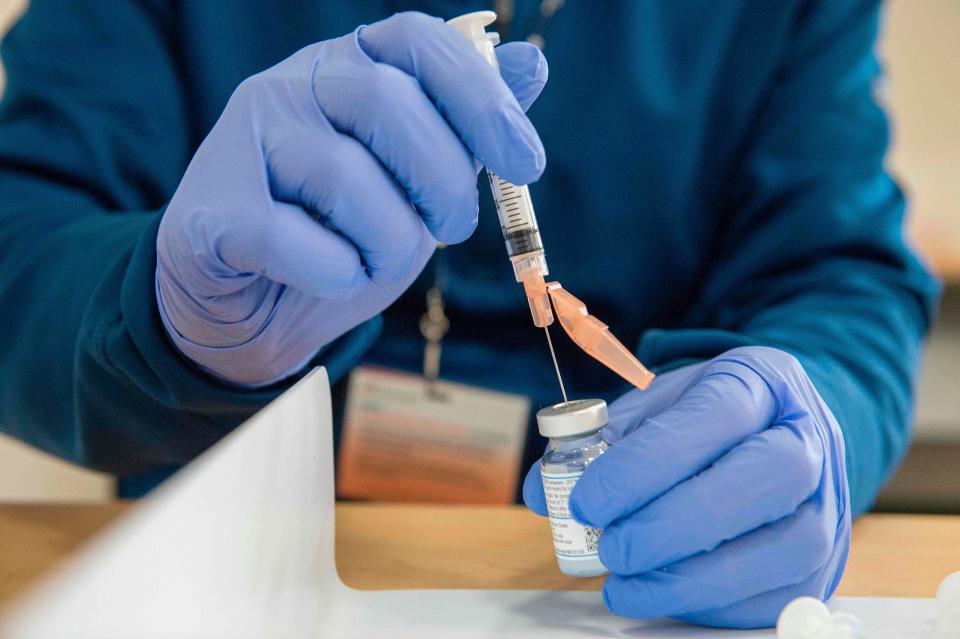Don't get lulled by COVID-19 vaccine. Stay careful and free up hospital space for others.
After nearly a year of treating very ill, hospitalized patients with COVID-19, I received a letter from a patient I had cared for in March. The previously healthy 35-year-old professional had spent a month on the ventilator and his muscles had atrophied so much that he had lost the ability to walk. Ten months later, he wrote to tell me that he has finally fully recovered and can run miles. I was heartened to hear how far he had come.
Unlike my patient though, as a nation we are still finding our footing with this pandemic. We have made a great deal of progress in understanding the virus and are now armed with proven therapeutics and vaccines. However, in many ways, the worst aspects of the pandemic have not changed: My hospital wards are still filled with patients struggling to breathe, intensive care units are full, and after more than 424,000 deaths, we are still fighting the perception that this virus is not lethal.
Daily toll higher than 9/11
The death toll is on track to pass a half million in February, which is impossible to fathom. At nearly 4,000 deaths per day, that’s the magnitude of a Sep. 11 attack spread across the nation. Per day. Spend an afternoon in the hospital, and the numbers start to become entirely believable. Hospitals across the nation have dedicated COVID-19 units, and even then, more space is needed.
Every day I go to work, I have a growing census of patients, young and old, who are struggling to breathe even on incredible amounts of oxygen. Some recover, some are destined for weeks on the ventilator and some die. Even those who recover are left worse for the wear with persistent fatigue, post-traumatic stress disorder and asthma-like conditions.

Rather than ramp down with the end of 2020, cases and deaths from COVID-19 reached all-time highs. We have easily surpassed the 25 million mark for infected persons. More troublesome, we are again entering a phase of dwindling ICU beds, staffing and resources.
Many areas, including large cities like Los Angeles, are in a state of emergency where oxygen has become a precious resource and is being rationed only to those with the best chances of survival.
Not only is this dangerous to those infected with the coronavirus, but it is also life threatening to anyone else who becomes sick or injured. Suffering a heart attack or even getting into a car accident becomes that much more hazardous when the health care system is strained. Even doctors and nurses are becoming in short supply.
Bridging the gap: COVID safety precautions are as important as ever. Here's how to persuade resisters.
After nearly a year of this, health care workers are getting tired. Burnout rates are high, with some states unable to find enough nurses. With all the hard work being done, it is incredibly discouraging to see our fellow citizens ignoring our recommendations and realities. More than 8 million people traveled by air in the United States in the last week of 2020, which increased transmission of the coronavirus and led to the spikes of cases we are seeing.
This past week, I personally treated several patients who traveled for the holidays and have not been able to return as they and their families suffer from COVID-19. And now California has lifted its curfew and stay-at-home orders, which will tempt many people to resume a more normal routine.
Stay vigilant even after after vaccine
I get it. Just as health care workers are tired, the public is also fatigued from relentless COVID-19 precautions. But this is not the time to let up. Vaccines are now a reality, and though the national rollout has been chaotic and confusing, the shot will eventually be available to you. When it is, please take it.
The vaccines are safe and tested, and provide significant protection from the virus and its new variants. There are mild side effects of fatigue, body aches and fevers that many experience, especially with the second shot, but they're nothing compared with the actual symptoms of COVID-19. In addition, you will protect the community by reducing your chances of needing hospitalization, which frees up medical resources. This is what will lead to a sustained #flattenedcurve.
Complicated calculus: Who should get vaccine now and who should wait?
Do not give into COVID fatigue. Continue to wear masks and socially distance. Until most of the nation is vaccinated, the chances of viral transmission, hospitalization and death remain high for everyone, not just the vulnerable. Because the vaccines are not 100% and take time to reach peak efficacy, these precautions will still be necessary.
The idea that you could go back to a normal life five minutes after getting vaccinated is unrealistic and dangerous. More likely, we will see some return to normalcy in the second half of the year.
It has been a long road, and will continue to be difficult for the time being. But like my patient who learned to walk again, we will recover. We just need to resist COVID fatigue, stay motivated, listen to public health experts and continue to move forward like my patient did — one step at a time.
Dr. Thomas K. Lew is an assistant clinical professor of medicine at the Stanford University School of Medicine and an attending physician of Hospital Medicine at Stanford Health Care – ValleyCare. All expressed opinions are his own. Follow him on Twitter @ThomasLewMD
You can read diverse opinions from our Board of Contributors and other writers on the Opinion front page, on Twitter @usatodayopinion and in our daily Opinion newsletter. To respond to a column, submit a comment to letters@usatoday.com.
This article originally appeared on USA TODAY: Get COVID vaccine but don't go back to normal, it's not safe yet: Doctor

 Yahoo Movies
Yahoo Movies 